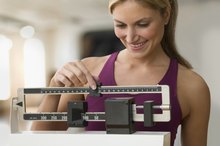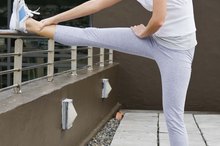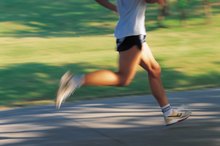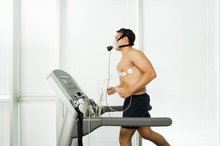Calories Burned at Rest
Believe it or not, most of the calories your body burns are burned at rest. This includes while you are sleeping, eating, sitting at your desk, sitting in front of the TV or engaging in any other sedentary behavior. That does not, of course, mean that doing more sedentary activities will make you burn more calories; you burn many more calories per minute by being active. However, knowing how many calories your body burns at rest is a valuable piece of information for effective weight management.
Sources of Calorie Consumption at Rest
Your body burns calories at rest to maintain its basic functions. For instance, it takes energy, or calories, to keep your heart beating, your lungs breathing and your brain cells communicating. The number of calories it takes to accomplish these basic functions, excluding any physical activity, is your resting metabolic rate or RMR. You also burn calories at rest by digesting food; this is called thermogenesis, or the "thermic effect of food." The final source of calorie consumption is physical activity. Most definitions separate RMR from thermogenesis in accounting for total calories burned, but they are similar in that they both occur at rest, independent of physical activity.
Significance
How Does Exercise Affect Breathing?
Learn More
The main significance of one's RMR is in determining the appropriate number of calories a person should consume daily. It is helpful to know how many calories you burn through exercise, but even in a very active person, RMR still accounts for about 60 percent of total calories burned. Weight management is a balance of calories consumed through food vs. calories burned. Therefore, by knowing your RMR, you have a large piece of the puzzle and can better adjust your caloric intake to help gain, lose or maintain body weight.
Measurement
Fairly accurate measurements of RMR can be achieved by using a machine that measures a person's oxygen intake and carbon dioxide output at rest, such as one from New Leaf Fitness. For this assessment, a person sits in a comfortable chair in a dark room and focuses on relaxing for several minutes while a device attached to a mask measures the person's oxygen consumption. These assessments are available in many health clubs. Other types of tests may be available in a more clinical setting. There are also formulas to estimate RMR based on height, weight, age and gender, such as the calculator at www.shapeup.org. Everyone is different, so such calculators may be more accurate for some people than for others, but if an oxygen consumption test is not an option for you, they can be a helpful tool.
Changing Resting Metabolic Rate
How to Use Your BMR to Lose Weight
Learn More
Although genetics play a role in determining a person's RMR, many lifestyle factors contribute to its increase or decrease. The best way to increase RMR is to build lean muscle tissue, which is very metabolically active, meaning that the body burns a lot of calories just to keep the tissue healthy and functioning optimally. Stored fat, on the other hand, is not very metabolically active. Exercise, particularly resistance training, will help build and maintain lean muscle tissue.
A decrease in metabolic rate occurs when lean muscle tissue deteriorates due to physical activity. RMR can also decrease if a person consumes too few calories over a significant period of time. The body essentially flips into starvation mode and tries to consume as few calories as it can. Extreme, or "yo-yo" dieting, often causes a decrease in metabolic rate over time that makes long-term weight loss very difficult.
Misconceptions
One of the biggest myths surrounding resting metabolism is that it slows with age. While metabolism does seem to slow as you age, and weight gain tends to increase, the truth is that very little of this effect is due to age itself. It is mostly the result of less physical activity, which reduces the amount of metabolically active lean muscle tissue in the body. Poor nutrition choices also contribute to this apparent slowing of metabolism.
Another myth is that losing weight will speed up a person's metabolism. While replacing fat with lean muscle tissue, usually the result of exercise and improved fitness, will increase resting metabolism, losing significant amounts of weight can actually decrease RMR because the body does not have to work as hard to accomplish its basic functions when it is carrying around less weight. This misconception is often responsible for plateaus in weight loss.
Related Articles
References
- American Council on Exercise; "Lifestyle and Weight Management Consultant Manual"; 2004
Writer Bio
Andrea Johnson is a certified personal trainer and lifestyle and weight management consultant through the American Council on Exercise (ACE). She has a B.A. in biology from the University of St. Thomas, St. Paul, Minn., and also a J.D. from the University of Minnesota. She began writing for various online publications after four years working as a personal trainer and wellness coach.








